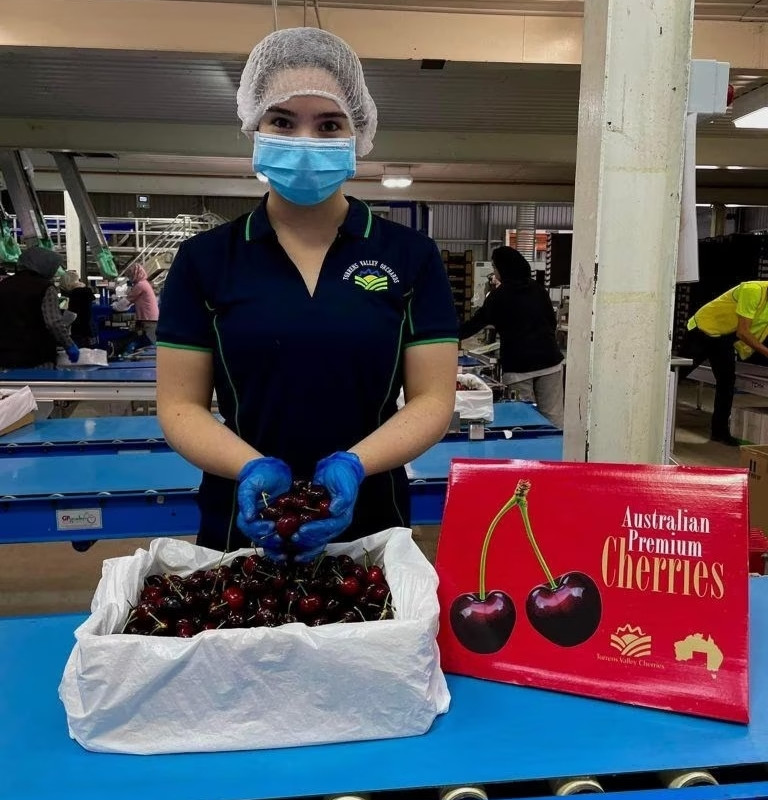A recent report prepared by the United States Department of Agriculture (USDA) predicts that cherry production in Australia for the 2024/25 season will reach 20,000 tons, a volume that reflects an increase compared to the revised estimate of 18,500 tons for the 2023/24 season. This production forecast reflects a 17% increase compared to the previous five-year average and an 8% increase over last season's volumes.
The forecast remains moderate, in line with the two previous results of recent years, despite the growth in the country's cherry plantings. The projected increase for the 2024/25 season is primarily due to expectations of favorable growing conditions. Additionally, it reflects the fact that the 2022/23 harvest was significantly below normal due to unusually wet conditions during harvest in New South Wales and Victoria.
Production in 2023/24 was significantly below expectations due to a second consecutive year of wet conditions during harvest in the same regions, although the impact was less severe.
In most of the major cherry-growing regions, temperatures were average to below average in late autumn and winter, with lower minimum temperatures than the previous year in these areas. This allowed cherry farms to have more than sufficient winter chilling hours.

Cherry Markets
With an 8% increase in production expected for the 2024/25 season and a rise in imports, domestic consumption is expected to be around 17,000 tons, almost 10% higher than the estimated 15,500 tons in the previous year.
Supply chain and availability issues diminished over the course of the 2023/24 season. For the current season, factors affecting domestic cherry consumption are expected to be the overall production level and fruit quality.
Good climatic conditions are expected to lead to an increase in cherry exports, which could limit supply growth for the domestic market. However, consumption is expected to reach levels typically associated with high production years.
At this point, the USDA report highlights that fresh cherry exports will increase significantly to 5,000 tons in the 2024/25 season, a 20% jump from the revised estimate of 4,000 tons for the 2023/24 season. If achieved, this projected export level will be the second highest on record, aligning with export volumes reached over the last decade when production was similar to that forecast for the 2024/25 season.
Due to the expected climatic conditions, the USDA anticipates that a higher percentage of quality cherries will be allocated for export, supporting a strong foreign trade program for the current season.
Tasmania's cherry production is highly dependent on the export market since its harvest period does not coincide with the peak domestic demand period before Christmas. The island's cooler and slower-growing climate in southern Australia is more suited to producing high-quality cherries, making them more attractive for export.
With better growing conditions anticipated this year compared to the 2023/24 and especially the 2022/23 seasons, an increase in the volume of cherries exported from Victoria and New South Wales is expected. These regions were previously affected by excessive spring rains.
Production Areas
The main cherry production regions in Australia are concentrated in the Huon Valley in Tasmania, the Goulburn Valley in Victoria, Young and Orange in New South Wales, and the Adelaide Hills in the south of the country. Smaller production regions include Stanthorpe in southern Queensland, the southeastern corner of Western Australia, the Yarra Valley in Victoria, and parts of New South Wales.
Tasmania is the southernmost region with the coolest climate and longest growing season, which allows for the production of abundant and high-quality cherries. The downside is that its harvest season is also the latest among all regions, mostly after the peak Christmas demand, resulting in a focus on export markets.
The more northern regions have a warmer and less optimal climate, but harvesting begins in late October, aligning with the optimal period of domestic demand that precedes Christmas.
Source: Más Producción
Image: Más Producción
Cherry Times - All rights reserved













